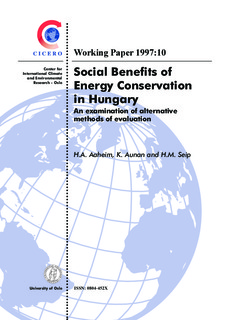| dc.description.abstract | This study aims at comparing alternative methods for a valuation of the social benefits of less air pollution. Estimates of such benefits can be based either on the economic consequences of less damage associated with pollution, or on estimates of the willingness to pay for less pollution. The damage cost approach is based on relatively reliable data, but disregards direct welfare gains of a better environment. Such gains can be assessed by the willingness to pay approach, which, however, is problematic for methodological reasons. In this study, we assume that it is possible to estimate the willingness to pay in a meaningful way.
Using a program for conservation of 64 PJ fossil energy in Hungary as a case, the damage cost approach estimates the benefits to be nearly 75 mill. USD per year, dividing into approximately 41 mill. USD for health, and 33 mill. USD in material damage. The willingness to pay approach, on the other hand, yielded a value of 1.9 bill. USD. Most of this difference is due to the different estimates for chronic distresses and early death. Ignoring methodological problems, the main reason why the two approaches diverge is that both refer to an initial situation, before the reduction in air pollution has taken place. The ‘correct’ estimate would be to calculate value and quantity of reduced emissions in equilibrium, after the Energy Program has been implemented. To do this, a very simple and aggregated macroeconomic model was applied.
The equilibrium point on the Energy Program curve was estimated to be 70 PJ, or approximately 10 percent above the reported amount of energy conservation in the program. The marginal cost of the program is 7.5 mill. USD/PJ, while the marginal cost in equilibrium (the price of energy conservation) was estimated to 27 mill. USD/PJ. With more moderately increasing abatement cost, the price of energy conservation in equilibrium was 21 mill. USD/PJ, yielding a total cost of 1.9 bill. USD for energy conservation. This is the same as the willingness to pay for the program in the bottom-up approach. The corresponding energy saving was 91.2 PJ. If the willingness to pay is reduced to ¼, the price of energy conservation dropped to 5.1 mill. USD/PJ. This means that a small part of the Program should be discarded.
The results of the different approaches should not be regarded as alternative answers to the same question. Rather, the damage cost and the willingness to pay assessments can be considered as necessary components of a macroeconomic study of environmental policy. To carry out a study relevant for policy making, however, requires better data, especially on economic conditions. | nb_NO |
